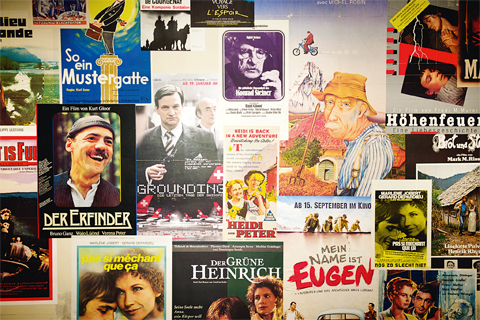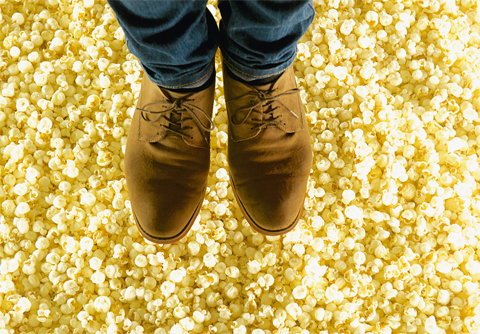The soul image of the country
In the Landesmuseum in Zurich, a moving exhibition is flickering across ten mini-cinemas until mid-October. Curator Walter Keller has searched through 300 films for scenes from everyday life in Switzerland that are as meaningful as possible.
Feature films are a means of expression of their time. What was meant by "Switzerland" at a certain time? How do the Swiss live and think? The exhibition "Great Cinema" at the National Museum has sought answers to these questions in Swiss feature films. Walter Keller and his team analyzed around 300 films. "This was not about cinematic art or film-scientific criteria. We were interested in the question: could it smell like Switzerland in this film?" the curator explained at the opening. Out of 900 sequences of the "Helvetia" scent mark, 115 finally made it into the final selection from 111 films.

These moving moments of 1 to 3 minutes brevity have been assembled into 10 new thematic strips. The editing plan for these statements on the "soul image of the country" was not chronology, but creative association. In the questioning clips, films from all epochs and genres mix to form a new dialogue. This is to be perceived by the audience as a matter of course. In the exhibition, which is intended to stimulate reflection, any commentary was deliberately dispensed with. Keller only made a brief comment at the opening: "Old Swiss film is far from being conservative, and today's color films are not automatically critical either."

The exhibition organizers have unearthed their puzzle pieces of the national soul "in a thankful way" from Swiss film distributors and to a large extent also from the archives of Swiss television. Nathalie Wappler, head of the culture department at SRF, said in her introduction that many of these films "contrast life with stories " and thus also explore the boundary between fiction and reality. Switzerland between dream and reality. Refugees also experienced this separation in several films. It is striking that works from this genre seem to be among the most impressive that Swiss film artists know how to tell. The refugee drama "The Last Chance" by Leopold Lindtberg was honored with the Golden Globe in 1946 as well as the main prize in Cannes. "Das Boot ist voll" by Markus Imhoof was nominated for an Oscar in 1982. "The Voyage of Hope" by Xavier Koller won one in 1991. These three works support the memory of Switzerland in the "Great Cinema". Others also engage in intellectual national defense. Or they unmask our character in comedies like "Taxi Driver Bänz", "Uli the Servant" or "Les petites fugues" to "Grounding". The films shown date from 1920 to the present. In the individual cinemas they are arranged according to 10 themes.

Freedom and neutrality: Freedom means being able to choose and decide between different options. Citizens should participate in the decisions of the general public. Democracy against the inside and armed neutrality against the outside are to secure freedom. To defend this good, every Swiss is obliged to serve in the militia army.
Lifetime - Season: Rituals of the course of life and the year are popular in feature films. They foster a sense of community in independent regions and communities. Life events - birth, baptism, wedding, folk festivals, processions, death - are occasions to consolidate the community or to set oneself apart from it.
You and us: For centuries, Switzerland is a barren and poor country. Then it recognizes the opportunities offered by the mountains, valleys and lakes. Their industrial and touristic use becomes possible with increasing mobility and contributes to the prosperity of Switzerland since then. But are the strangers who want to visit or live in the country lucky or unlucky for Switzerland?
In need: Abortion, moonlighting, child abuse, hunger, theft, rape, disruption, loneliness, suicide: tension arises when people and their loved ones are in distress. Through their own fault or the fault of others. Power and money are popular elements of film scripts. They are leitmotifs that drive stirring narratives of distress and strife. Love: Physical lust and desire are a rather rare commodity in Swiss feature films. Intentional or coincidence? Cupid's arrows buzz briskly through the air, but they rarely hit the right ones. Thus, love is not always completely voluntary, entirely befitting one's status or happy. And not always legally.
Generations: Films rarely tell stories of intact families. Rather, they find material in endangered, tragic or unhappy life circumstances. Films about tensions between parents, children and relatives - in rural-traditional or urban-modern settings - search for a sense of cohesion. Or they tell of the coldness of contemporary society.
Work - departure: Classic depictions of industrial work are rare in Swiss feature films. Scenes of farm work and glimpses of everyday office life are the rule. The financial center, livestock and agriculture seem more suitable as film material. The historical change in the world of work takes place without crises of modernization, such as can be found in English films.
Faith: Christian rituals such as baptism, marriage and burial or table, evening and intercessory prayer are deeply rooted in the lives of people in early films. Conquering the mountains to use them for water and pasture, to open up the peaks for tourism, and to bore through the Alps require daring construction and engineering skills.
Origin - Myth: Feature films have a hard time with complexity. They need heroes and antagonists. The figure of the crossbowman William Tell plays an important role in Swiss feature films. How he shoots the apple off his son's head on the orders of the authorities is first portrayed full of pathos and - in later films - ironically or satirically. The same happens to historical loyalty oaths and battles.
Nature - Culture: Nature is the only resource of our country. Its existential significance finds its counterpart in a rich tradition of moving productions. For modern man, nature serves as a counter-world to the "city" and stands for health, freedom and ecology - or for backwardness. There are numerous depictions of destructive natural forces: rockfalls, avalanches, glacial fractures, floods.
Those who wish can also rediscover 29 films in their entire length in parallel events. There is also a DVD store and a lunch cinema at the Landesmuseum.
Andreas Panzeri









